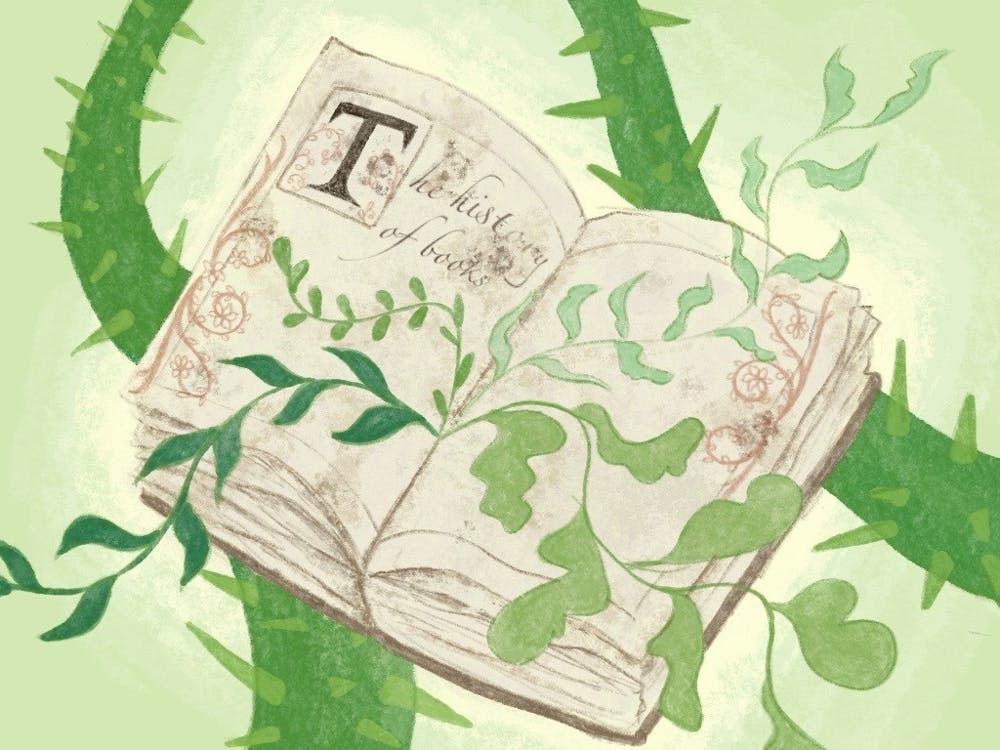If humanity could be summed up in one word, that word would be “books.” Our history with language and writing is woven into our beings, binding our pasts, presents and futures. Each word we write is a personal nebula, creating new stars, new stories, new experiences that shine for millions and billions of years.
Books are wombs; they create and cultivate the thoughts of a singular mind. They’re a reflection of the self, a mirror image of our minds.
Books are tombs; they offer a chance of immortality, a chance to stake a claim and say “I was here.” It’s a way of living even after death, inspiring the minds of young nebulae to make their own stars.
Our history as humans is interwoven with that of the book—with its early beginnings, its creation and its evolution. To understand humanity, all one has to do is read.
Humans have been developing written language far before the first book, though that in itself is a debate of its own. People attribute the title of the "First Book” to a plethora of people and works, and it’s hard to pin down an exact answer when the definition of a book is more fluid than people think.
Dr. Michael Weisenburg is the Associate Director of the Irvin Department of Rare Books and Special Collections at the University of South Carolina. This department belongs to the Hollings Library, which is one of many special collections in the university system. It was built in 2010 largely because there wasn’t enough space in Thomas Cooper Library to hold all of the new material that the university was bringing in. The collection juts off from the back of Thomas Cooper on the main floor, and it’s home to a number of Hollings departments, including Rare Books, which houses a range of texts dating back hundreds of centuries.
“Most of the building is really a giant refrigerator for paper,” Weisenburg explained. To protect and preserve the materials, they’re placed in rooms with carefully curated temperatures and humidity levels. This way, these hundreds- and sometimes thousands-year-old materials are kept in their best conditions.
Due to the nature of his job, Weisenburg constantly works around old, medieval and even ancient texts. Just like many other scholars, he believes that what’s considered the “First Book” depends on what an individual defines a book as.
According to Weisenburg, the secret to this debate is buried deep in human history, dating all the way to Sumerian cuneiform tablets, an ancient writing system created in southern Mesopotamia sometime in 3400 BCE.
“I think it's worth considering a cuneiform tablet a book, even though it doesn't have a front and a back, it doesn't have pages, it doesn't look like what we think a book looks like, but it is the invention of writing,” Weisenburg pointed out. “It's the invention of archives, it's the invention of literate storytelling.”
Most of the cuneiform fragments that researchers have been able to collect and preserve are bits and pieces of ancient accounting and prayers. The Hollings Library has a few cuneiform fragments in their collection, though they’re Babylonian rather than Sumerian.
"The oldest pieces of writing we have in the collection are these receipts,” Weisenburg clarified. “One's a receipt for sheep and goats, the other's a receipt for beer. And then the other piece we have here is a prayer to the goddess, Ishtar.”
Transactions and receipts: both are unmistakably human. It’s almost poetic how the most frequent fragments of ancient texts researchers uncover revolve around trade or religion. It shows just how consistent humanity truly is and how we value the same things even thousands of years later.
Cuneiform wasn’t just used for prayers and receipts—the ancient Sumerians also wrote their own literature on these ancient tablets. If Weisenburg’s idea of a book is correct, then the Sumerians' "Epic of Gilgamesh" would be considered the first book. This long, narrative poem was written completely in cuneiform in about 2000 BCE. Humanity has been creating since its own creation, a fact that permeates our history. While the "Epic of Gilgamesh" may be the first book, it certainly was not the last.
The book as we know it hasn’t always looked like it does now. Its ancestors date back to cuneiform writing—clay and stone was our ancestor’s go-to medium. But these ancient tablets were heavy, tedious and destined to be replaced by something like papyrus scrolls centuries later. Originating in Egypt, these scrolls were made out of tall reeds scattered around the banks of the Nile. Papyrus scrolls quickly became the most popular writing medium of its day, giving Egypt almost complete control over its production and trade. According to Weisenburg, historically important works such as the "Book of the Dead," the "Odyssey" and the books of the Bible were written on these scrolls.
But the book does not stay stagnant for long. Soon, parchment outshined papyrus, and the Romans began folding and sewing these pieces of parchment together, using wood for binding. The codex was born, and its resemblance to the books we know today is uncanny.
“It's got a cover and a spine and it's got pages in it,” Weisenburg explained. “But it's all written by hand, and this is not paper, this is animal skin. This is vellum.” The parchment used in codices are made from animal skin, and each individual page is written by monks in scriptoriums which were found in monasteries across Medieval Europe. Codices were largely used for religious texts, their rise to fame coinciding with that of Christianity, and scribes would typically use different kinds of inks like lapis lazuli and even gold when writing these works.
Though the codex was revolutionary at the time, the hand-writing process was a tedious one, and books did not truly become widespread until the eventual invention of the printing press. Most people attribute the creation of the modern printing press to Johannes Gutenberg in 1450, but books were being printed much earlier in many East Asian countries. In fact, the first printed book was "The Diamond Sutra," which was written in China during the Tang Dynasty and used block-printing. Even the first example of movable type is found in China—its creator, Bi Sheng, used clay and iron in his printing process, though Wang Cheng later replaced that clay with wood. Gutenberg eventually created his own printing press in Mainz, Germany, utilizing metal instead of wood and changing the printing game in Europe.
With the creation of the printing press came the boom of book production. It was more efficient and less time-consuming, which eventually led to easier access: not only to books, but also to pamphlets, broadsides, newspapers and magazines. Journalism was born from the printing press—a new way for people to read, write and spread news was on the horizon.
“The printing press is going to allow faster, more immediate literature,” Weisenburg explained. “It's going to allow more people to have access to literature, and so they will become literate; they'll learn to read and write. And most importantly, it's going to create an investment in what's called vernacular literature.”
Beforehand, any distributed works were written in Latin, following the guidelines of the church and the lingua franca of Europe. Now, with the ability to mass print books, more people were able to read texts in their own language. Accessing these works became less and less of an issue.
It took a few hundred years for the novel to come into play. Weisenburg describes the novel as more of a genre than a medium like cuneiform tablets or medieval codices. Novels are their own subsection of humanity, as they represent a distinct creativity that was unlocked with the rise of printing.
“But culturally because of serialization,” Weisenburg began, “because of this move towards vernacular literature, you're going to start seeing in the 18th century more people interested in stories that are about people, not necessarily about history, and they're going to be interested in stories that are about their contemporary moment.” A novel is not the same thing as a book, for the book is the medium while the novel is what’s stuffed inside it. Novels became a new way to tell a story—to share a part of oneself—and it’s incredibly intertwined with American society.
Weisenburg emphasizes how, up until the 19th century, the novel was more of a European rather than American concept, and the idea of there even being an “American Novel” was laughable to the likes of Rev. Sydney Smith, a man who in 1820 wrote an article criticizing American sophistication. As America tried to solidify itself as its own country and establish its own sense of identity, these concerns were projected into the evolution of the American novel.
“So the notion of the American novel is really a question of what versions of the stories we tell about ourselves make us feel like we have a cultural identity that's consistent with other people,” Weisenburg said. The Great American Novel is generational, and while there are a few works that are generally labeled as such, like "The Great Gatsby," the concept hinges on its reflection of American society during its creation. In true American fashion, these writers hoped to separate themselves from Britain and show just how different they were in comparison with their predecessor.
Humanity always has reasons for doing things. Creating and developing written languages, taking the time to develop the book as a medium and mass producing ancient, historical and modern works is not something done on a whim. To understand the book's evolution, one must question its purpose. Why did the Sumerians take the time to carve and bake clay? Why did medieval monks dedicate themselves to handwriting hundreds of codices? Why were we compelled to create something as world-changing as the printing press?
Just like the book, the answer involves an evolution.
According to Weisenburg, it started with a complex economy. Ancient Sumer needed these cuneiform tablets to document trade and commerce. Slowly, that morphed into a different kind of exchange, heavily impacted by culture. Prayers, chants and hymns became just as important as accounting, and soon enough these turned into poems and the fascinating "Epic of Gilgamesh."
Why? Humans need to feel like individuals. They need to leave a part of themselves behind; they need to feel immortal.
“Writing is a way to live forever,” Weisenburg explained. “Publishing is a way to live forever.” Though it may seem extreme, this idea of immortality—to leave a mark on this world—is seen across multiple literary works. The "Epic of Gilgamesh" and "The Iliad" are proof of this innate drive.
Humanity’s need for immortality exists across all of time. It exists in the Great Pyramids of Egypt, it exists in the strokes of paint on Da Vinci’s canvas and it exists on a personal bookshelf wedged between the longings of someone else’s dream. This need to craft one’s own individual identity and separate oneself from the rest of the noise is integral to human evolution. Without it, the book would never be what it is today.
From transactions carved in baked clay to hand-decorated animal hide bound with wood to glued paperbacks and hand-held eBooks, the book has come a long way. As the medium of humanity’s ego, it was forced to adapt alongside us and to carry this subconscious aspiration.
“There's this desire to live past ourselves and to be remembered,” Weisenburg said. The book is the physical manifestation of this desire. What humanity creates and what humanity writes can live as long as we do.
But maybe when humanity comes and goes, wiped out in tens or hundreds or thousands of years, the species of tomorrow will find some use in the books we wrote and the stories we’ve told. That’s all humanity can hope for.



